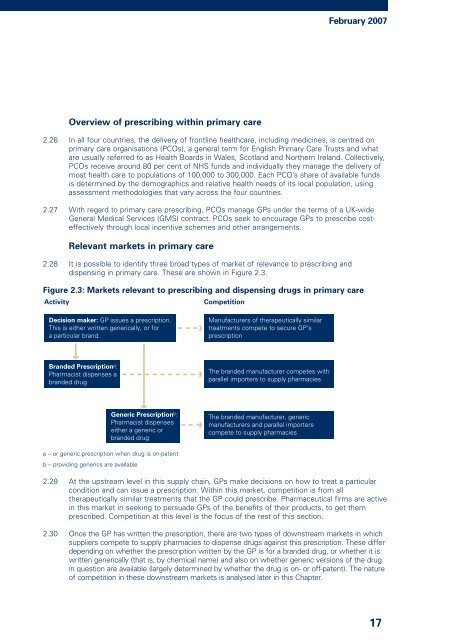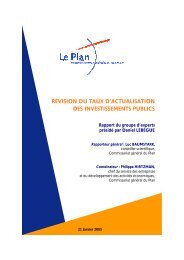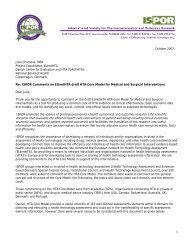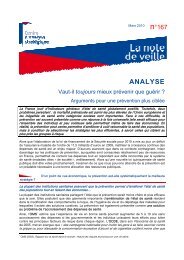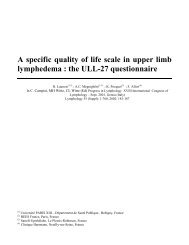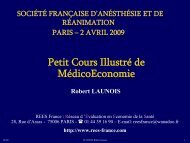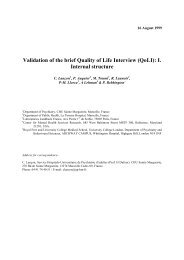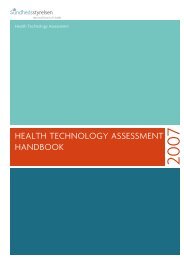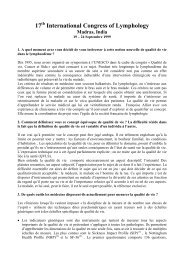The Pharmaceutical Price Regulation Scheme - Office of Fair Trading
The Pharmaceutical Price Regulation Scheme - Office of Fair Trading
The Pharmaceutical Price Regulation Scheme - Office of Fair Trading
Create successful ePaper yourself
Turn your PDF publications into a flip-book with our unique Google optimized e-Paper software.
February 2007Overview <strong>of</strong> prescribing within primary care2.26 In all four countries, the delivery <strong>of</strong> frontline healthcare, including medicines, is centred onprimary care organisations (PCOs), a general term for English Primary Care Trusts and whatare usually referred to as Health Boards in Wales, Scotland and Northern Ireland. Collectively,PCOs receive around 80 per cent <strong>of</strong> NHS funds and individually they manage the delivery <strong>of</strong>most health care to populations <strong>of</strong> 100,000 to 300,000. Each PCO’s share <strong>of</strong> available fundsis determined by the demographics and relative health needs <strong>of</strong> its local population, usingassessment methodologies that vary across the four countries.2.27 With regard to primary care prescribing, PCOs manage GPs under the terms <strong>of</strong> a UK-wideGeneral Medical Services (GMS) contract. PCOs seek to encourage GPs to prescribe costeffectivelythrough local incentive schemes and other arrangements.Relevant markets in primary care2.28 It is possible to identify three broad types <strong>of</strong> market <strong>of</strong> relevance to prescribing anddispensing in primary care. <strong>The</strong>se are shown in Figure 2.3.Figure 2.3: Markets relevant to prescribing and dispensing drugs in primary careActivityCompetitionDecision maker: GP issues a prescription.This is either written generically, or fora particular brand.Manufacturers <strong>of</strong> therapeutically similartreatments compete to secure GP’sprescriptionBranded Prescription a :Pharmacist dispenses abranded drug<strong>The</strong> branded manufacturer competes withparallel importers to supply pharmaciesGeneric Prescription b :Pharmacist dispenseseither a generic orbranded drug<strong>The</strong> branded manufacturer, genericmanufacturers and parallel importerscompete to supply pharmaciesa – or generic prescription when drug is on-patentb – providing generics are available2.29 At the upstream level in this supply chain, GPs make decisions on how to treat a particularcondition and can issue a prescription. Within this market, competition is from alltherapeutically similar treatments that the GP could prescribe. <strong>Pharmaceutical</strong> firms are activein this market in seeking to persuade GPs <strong>of</strong> the benefits <strong>of</strong> their products, to get themprescribed. Competition at this level is the focus <strong>of</strong> the rest <strong>of</strong> this section.2.30 Once the GP has written the prescription, there are two types <strong>of</strong> downstream markets in whichsuppliers compete to supply pharmacies to dispense drugs against this prescription. <strong>The</strong>se differdepending on whether the prescription written by the GP is for a branded drug, or whether it iswritten generically (that is, by chemical name) and also on whether generic versions <strong>of</strong> the drugin question are available (largely determined by whether the drug is on- or <strong>of</strong>f-patent). <strong>The</strong> nature<strong>of</strong> competition in these downstream markets is analysed later in this Chapter.17


